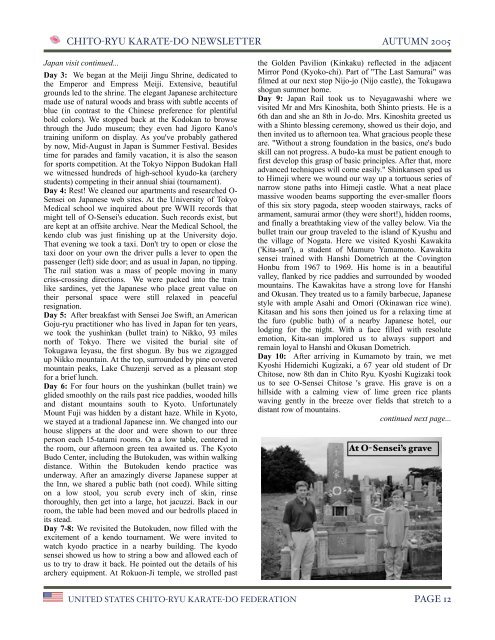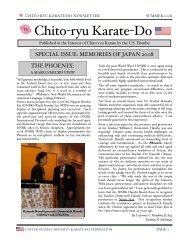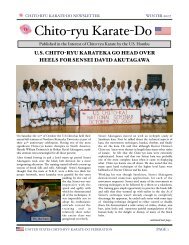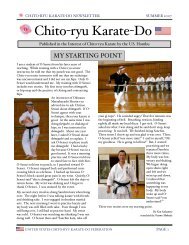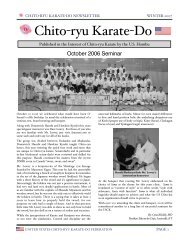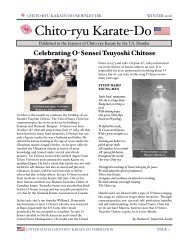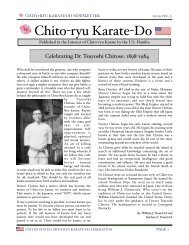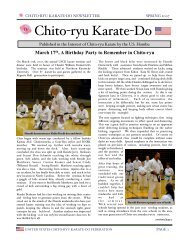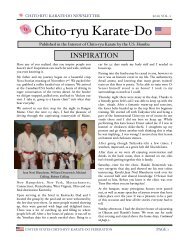Confucius - United States Chito-ryu Karate Federation
Confucius - United States Chito-ryu Karate Federation
Confucius - United States Chito-ryu Karate Federation
You also want an ePaper? Increase the reach of your titles
YUMPU automatically turns print PDFs into web optimized ePapers that Google loves.
CHITO-RYU KARATE-DO NEWSLETTER AUTUMN 2005<br />
Japan visit continued...<br />
Day 3: We began at the Meiji Jingu Shrine, dedicated to<br />
the Emperor and Empress Meiji. Extensive, beautiful<br />
grounds led to the shrine. The elegant Japanese architecture<br />
made use of natural woods and brass with subtle accents of<br />
blue (in contrast to the Chinese preference for plentiful<br />
bold colors). We stopped back at the Kodokan to browse<br />
through the Judo museum; they even had Jigoro Kano's<br />
training uniform on display. As you've probably gathered<br />
by now, Mid-August in Japan is Summer Festival. Besides<br />
time for parades and family vacation, it is also the season<br />
for sports competition. At the Tokyo Nippon Budokan Hall<br />
we witnessed hundreds of high-school kyudo-ka (archery<br />
students) competing in their annual shiai (tournament).<br />
Day 4: Rest! We cleaned our apartments and researched O-<br />
Sensei on Japanese web sites. At the University of Tokyo<br />
Medical school we inquired about pre WWII records that<br />
might tell of O-Sensei's education. Such records exist, but<br />
are kept at an offsite archive. Near the Medical School, the<br />
kendo club was just finishing up at the University dojo.<br />
That evening we took a taxi. Don't try to open or close the<br />
taxi door on your own the driver pulls a lever to open the<br />
passenger (left) side door; and as usual in Japan, no tipping.<br />
The rail station was a mass of people moving in many<br />
criss-crossing directions. We were packed into the train<br />
like sardines, yet the Japanese who place great value on<br />
their personal space were still relaxed in peaceful<br />
resignation.<br />
Day 5: After breakfast with Sensei Joe Swift, an American<br />
Goju-<strong>ryu</strong> practitioner who has lived in Japan for ten years,<br />
we took the yushinkan (bullet train) to Nikko, 93 miles<br />
north of Tokyo. There we visited the burial site of<br />
Tokugawa Ieyasu, the first shogun. By bus we zigzagged<br />
up Nikko mountain. At the top, surrounded by pine covered<br />
mountain peaks, Lake Chuzenji served as a pleasant stop<br />
for a brief lunch.<br />
Day 6: For four hours on the yushinkan (bullet train) we<br />
glided smoothly on the rails past rice paddies, wooded hills<br />
and distant mountains south to Kyoto. Unfortunately<br />
Mount Fuji was hidden by a distant haze. While in Kyoto,<br />
we stayed at a tradional Japanese inn. We changed into our<br />
house slippers at the door and were shown to our three<br />
person each 15-tatami rooms. On a low table, centered in<br />
the room, our afternoon green tea awaited us. The Kyoto<br />
Budo Center, including the Butokuden, was within walking<br />
distance. Within the Butokuden kendo practice was<br />
underway. After an amazingly diverse Japanese supper at<br />
the Inn, we shared a public bath (not coed). While sitting<br />
on a low stool, you scrub every inch of skin, rinse<br />
thoroughly, then get into a large, hot jacuzzi. Back in our<br />
room, the table had been moved and our bedrolls placed in<br />
its stead.<br />
Day 7-8: We revisited the Butokuden, now filled with the<br />
excitement of a kendo tournament. We were invited to<br />
watch kyodo practice in a nearby building. The kyodo<br />
sensei showed us how to string a bow and allowed each of<br />
us to try to draw it back. He pointed out the details of his<br />
archery equipment. At Rokuon-Ji temple, we strolled past<br />
the Golden Pavilion (Kinkaku) reflected in the adjacent<br />
Mirror Pond (Kyoko-chi). Part of "The Last Samurai" was<br />
filmed at our next stop Nijo-jo (Nijo castle), the Tokugawa<br />
shogun summer home.<br />
Day 9: Japan Rail took us to Neyagawashi where we<br />
visited Mr and Mrs Kinoshita, both Shinto priests. He is a<br />
6th dan and she an 8th in Jo-do. Mrs. Kinoshita greeted us<br />
with a Shinto blessing ceremony, showed us their dojo, and<br />
then invited us to afternoon tea. What gracious people these<br />
are. "Without a strong foundation in the basics, one's budo<br />
skill can not progress. A budo-ka must be patient enough to<br />
first develop this grasp of basic principles. After that, more<br />
advanced techniques will come easily." Shinkansen sped us<br />
to Himeji where we wound our way up a tortuous series of<br />
narrow stone paths into Himeji castle. What a neat place<br />
massive wooden beams supporting the ever-smaller floors<br />
of this six story pagoda, steep wooden stairways, racks of<br />
armament, samurai armor (they were short!), hidden rooms,<br />
and finally a breathtaking view of the valley below. Via the<br />
bullet train our group traveled to the island of Kyushu and<br />
the village of Nogata. Here we visited Kyoshi Kawakita<br />
('Kita-san'), a student of Mamuro Yamamoto. Kawakita<br />
sensei trained with Hanshi Dometrich at the Covington<br />
Honbu from 1967 to 1969. His home is in a beautiful<br />
valley, flanked by rice paddies and surrounded by wooded<br />
mountains. The Kawakitas have a strong love for Hanshi<br />
and Okusan. They treated us to a family barbecue, Japanese<br />
style with ample Asahi and Omori (Okinawan rice wine).<br />
Kitasan and his sons then joined us for a relaxing time at<br />
the furo (public bath) of a nearby Japanese hotel, our<br />
lodging for the night. With a face filled with resolute<br />
emotion, Kita-san implored us to always support and<br />
remain loyal to Hanshi and Okusan Dometrich.<br />
Day 10: After arriving in Kumamoto by train, we met<br />
Kyoshi Hidemichi Kugizaki, a 67 year old student of Dr<br />
<strong>Chito</strong>se, now 8th dan in <strong>Chito</strong> Ryu. Kyoshi Kugizaki took<br />
us to see O-Sensei <strong>Chito</strong>se 's grave. His grave is on a<br />
hillside with a calming view of lime green rice plants<br />
waving gently in the breeze over fields that stretch to a<br />
distant row of mountains.<br />
continued next page...<br />
At O-Sensei’s grave<br />
UNITED STATES CHITO-RYU KARATE-DO FEDERATION PAGE 12


